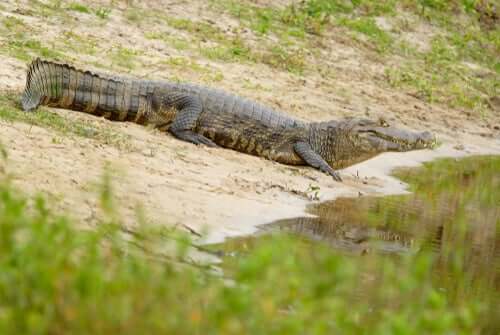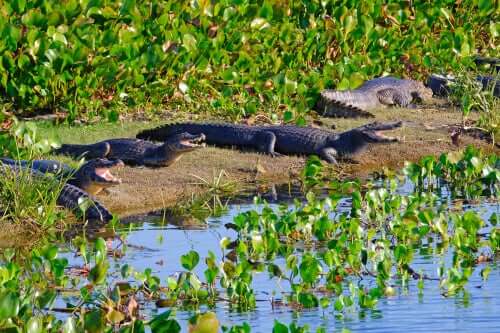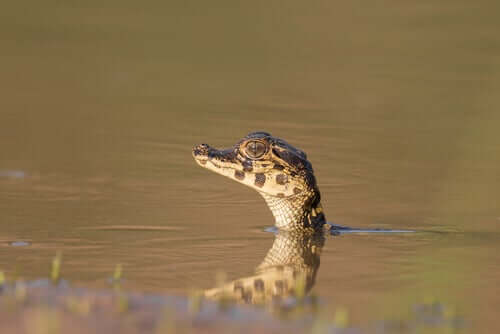The Main Characteristics of the Jacare Caiman

The Jacare caiman is a caiman species that originates from South America. It belongs to the Alligatoridae family and the Crocodilia order, and is related to both crocodiles and gavials.
The main characteristics of the Jacare caiman
The Jacare caiman’s scientific name is Caiman Yacare, but it also goes by many other names. For example, the Paraguayan caiman, the paranha caiman, the red caiman, and the southern spectacled caiman. This species has a long and narrow head, with a snout that is narrower towards the end.
The skin that covers this animal’s compressed body is practically impermeable. Another interesting characteristic is the muscular tail that this species possesses.
As for the coloring of the Jacare caiman, it differs between youth and adults. Younger Jacare caimans have an olive-colored tone, with blackish spots. At the same time, adults have a blackish coloring on their backs.
Males can reach up to 7.5 feet, although there are registers of Jacare caimans reaching up to 10 feet in length.
As for their mating season, males perform a dance in which they do pirouettes in the water. They have a very specific ritual that takes during the summer months. Males who have managed to impress females can approach them after the dance.
As for reproduction, Jacare caimans usually give birth to their young between the months of December and April. They place them in a nest they’ve built themselves out of organic waste and materials they find. These nests have a diameter of approximately 50 inches.

Habitat and distribution
Currently, this species resides in different countries of South America, including Argentina, Bolivia, Brazil, and Paraguay.
Caimans, like crocodiles and gavials, are always associated with water. Therefore, among the different locations where we can find the Jacare caiman, they prefer the clear water of rivers, estuaries, and lakes.
At the same time, they also enjoy lying in the sun by the edge of rivers and estuaries. In Brazil, they live peacefully alongside capybaras–the largest living rodent in the world.
The Jacare caiman’s state of conservation
The Jacare caiman falls into the category of least concern when it comes to conservation. Currently, experts are unaware of just how many individuals exist among the Jacare caiman population.
Poachers who hunt this species for its leather have posed the greatest threat, and this is still true today. In the 1970s, the population of Jacare caimans was a fraction of what it is today. This was fundamentally due to furtive hunting and illegal trafficking.
During the 19th and early 20th century, young Jacare caimans were a precious hunting object because of the leather extracted from their skin. However, conservationists then declared it as a protected species.
Preservation strategies
Governments have developed different preservation strategies in order to support this species’ recovery. One of the proposed options, which takes into account natural ecosystems, is to suggest the use of wild animal species.
To do so, they have proposed business strategies that involve a commercial benefit and stimulate the Jacare population in order to preserve the species.
Ranching
Countries like Argentina have developed species preservation strategies like “Project Jacare”. The objective here is egg ranching, taking advantage of the county’s wetlands in a sustainable way. At the same time, these endeavors support local commerce, like farming and shellfishing.
Egg ranching consists of obtaining eggs that these animals have laid in nature. The idea is to gather them early on or later, depending on the system used. Then, ranchers incubate the eggs artificially and raise the young reptiles in a controlled environment.
This process helps to prevents one of the critical factors, since this species of the Crocodilia order experiences a high embryonic mortality rate. Furthermore, those that do exist suffer from major depredation during their first year of life.
At the same time, these young can also develop stress illnesses. These are in response to cold temperatures during their first year of life, as well as the flooding of their nests.
When youth become relatively large, ranchers return them to nature. In doing so, they release a larger number of these reptiles in regions with the lowest densities.

Negative factors
Furthermore, among other measures, it’s also important to protect the areas where these animals build their nests. Experts have observed that females abandon their nests due to different disturbances caused by human beings.
These disturbances may involve direct human presence, or other issues resulting from human intervention. For example, the loss of habitat caused by the channeling of estuaries, causing wet areas to become dry.
While the Jacare caiman was once in danger some time ago, this is no longer the case. Thanks to preservation measures, they are no longer at risk of extinction.
All cited sources were thoroughly reviewed by our team to ensure their quality, reliability, currency, and validity. The bibliography of this article was considered reliable and of academic or scientific accuracy.
- Crocodile Specialist Group 1996. Caiman yacare. The IUCN Red List of Threatened Species 1996: e.T46586A11062609. http://dx.doi.org/10.2305/IUCN.UK.1996.RLTS.T46586A11062609.en. Downloaded on 22 July 2019.
-
National Geographic. Caimán yacaré [Internet]. www.nationalgeographic.com.es. 2013 [citado 23 de julio de 2019]. Disponible en: https://www.nationalgeographic.com.es/naturaleza/grandes-reportajes/el-retorno-del-caiman-2_7387/6
-
W. Prado et al. Estado de conservación de los caimanes de Argentina. Cuad herpetol 26 (Supl 1): 403-410 (2012) [Internet]. Disponible en: http://ppct.caicyt.gov.ar/index.php/cuadherpetol/article/view/2020/1733
-
Larriera, Alejandro y Imhof, Alba. Proyecto Yacaré. Cosecha de huevos para la cría en granjas del género Caiman en la Argentina. (Manejo de Fauna Silvestre en la Argentina. Programas de uso sustentable.):51-62. [Internet]. Disponible en: https://s3.amazonaws.com/academia.edu.documents/53333727/Libro_Uso_Sust_Fauna2006completo.pdf?response-content-disposition=inline%3B%20filename%3DManejo_de_Fauna_Silvestre_en_la_Argentin.pdf&X-Amz-Algorithm=AWS4-HMAC-SHA256&X-Amz-Credential=AKIAIWOWYYGZ2Y53UL3A%2F20190722%2Fus-east-1%2Fs3%2Faws4_request&X-Amz-Date=20190722T194636Z&X-Amz-Expires=3600&X-Amz-SignedHeaders=host&X-Amz-Signature=c0b8df44faf666c9041fef4d5e276868d75f13df1a61fbebafd195df9127869f#page=48